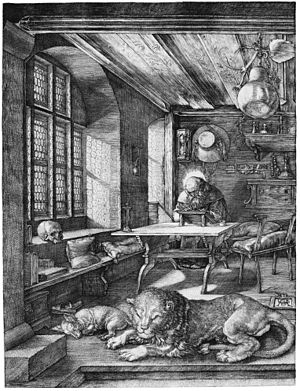Saint Jerome in His Study (Dürer)
| St. Jerome in His Study | |
|---|---|
 | |
| Artist | Albrecht Dürer |
| Year | 1514 |
| Type | engraving |
St. Jerome in His Study (German: Der heilige Hieronymus im Gehäus) is an engraving of 1514 by the German artist Albrecht Dürer. Saint Jerome is shown sitting behind his desk, engrossed in work. The table, on the corner of which is a cross, is typical of the Renaissance. An imaginary line from Jerome's head passing through the cross would arrive at the skull on the window ledge, as if contrasting death and the Resurrection. The lion in the foreground is part of the traditional iconography of St. Jerome, and near it is a sleeping dog, an animal found frequently in Dürer's works, symbolizing loyalty. Both creatures are part of Jerome's story in the Golden Legend (c. 1260), which contained fanciful hagiographies of saints.
St. Jerome in His Study is often considered as part of a group of three Dürer engravings, the other two being the well-known Melencolia I (1514) and Knight, Death and the Devil (1513). Together they have been viewed as representing the three spheres of activity recognized in medieval times: Knight, Death, and the Devil belongs to the moral sphere and the "active life"; Melencolia I represents the intellectual; and St. Jerome the theological and contemplative life.
The composition is intimate, but the viewer has difficulty locating himself in relation to the picture's space. Thomas Puttfarken suggests that while the scene is very close to the observer, Dürer did not intend the viewer to feel present: "the intimacy is not ours, but the saint's as he is engrossed in study and meditation" (94). Art historian Erwin Panofsky comments on the perspective:
The position of the sight point, quite far off centre, strengthens the impression of a representation determined not by the objective law of the architecture but by the subjective standpoint of the spectator who is just entering – a representation which owes to precisely this perspective arrangement a large part of its peculiarly 'intimate' effect. (Qtd. in Puttfarken, 94)
References
- Puttfarken, Thomas (2000). The Discovery of Pictorial Composition: Theories of Visual Order in Painting 1400–1800. New Haven & London: Yale University Press. ISBN 0-300-08156-1.

